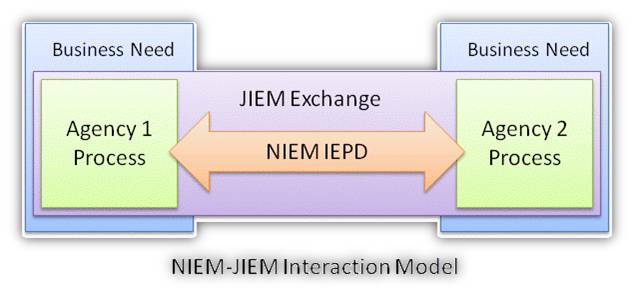What’s standing in the way of NIEM adoption?
I posted this response to a question on the LinkedIn NIEM group where someone asked about the slow rate of NIEM adoption; i thought i would cros post my response here.
What’s standing in the way of NIEM adoption?It’s about leadership.
- It’s about reducing complexity.
- It’s about getting the word out.
- It’s about opening up proprietary protocols.
- It’s about conformance.
- It’s even about standards.
What’s really standing in the way? Two things…a) utility and b) a market for it.
I think it would also be wise for us to take a few pages out of the eCommerce, EDI, EBXML world (and honestly, the internet as a whole). EDI became a standard because large companies said “if you want to do business with me, then you will stop faxing me POs and start sending them to me in this new thing called EDI. When XML appeared on the scene the same companies converted their information exchanges to EBXML and vendors and service providers folllowed suit – one might say if it weren’t for the EDI-to-EBXML movement, we might not even be talking about GJXDM or NIEM today; EBXML was groundbreaking in ts day.
So what’s in the way? I’ll look at this in terms of two things I mentioned above:
- Utility of NIEM– The “technology Acceptance Model” tells us that for increased adoption of a technology, it must be “useful and easy to use.” Today, however, we are having difficulty getting people to see the utility of NIEM, and it certainly has not proven itself to be easy to use either. Now, to be fair, NIEM started off life as dictionary of common data elements (words if you will) with working views of syntax and semantics. Then we have IEPDs. These are like sentences strung together, and by different authors, and the difficulty is that we don’t have a good way to know how well those sentences are strung together, whether or not we can assemble those sentences into comprehensible paragraphs, or even what “stories”(and where in those stories) those sentences might belong. In other words, I don’t think NIEM is coupled tightly enough to the business processes of Justice and Public Safety agencies. To become more useful, we must dust off JIEM, revalidate the inventory of Justice exchanges, and specifically tie them to NIEM IEPDs. And while we do this, we must clean up the inventory of IEPDs, remove ones that are toublesome, and reference those IEPDs back to the Justice business process and exchanges in JIEM.
- A Market for NIEM– Unfortunately, reuse has NOT always result in cost savings. There are a number of examples where agencies have had bad experiences with implementing NIEM, whether it was because of lack of skill of the integrator, poor IEPD design, poor project planning, immature integration tools, or good old politics, saying an agency will save money by using NIEM is not a strong position right now. To resolve issue (after we join NIEM and JIEM) I think we must attack the problem at the root–in the technology acquisition process. Stop with the buttons and bumper stickers and neat shirts (I have one too). What we need to do is drive NIEM use through RFPs and contracting processes. Of course, we have to first clean up the clearinghoue, but then we must help agencies to craft RFP language that they can use to call for use of NIEM and “NIEM-enabled” web services to effect the information exchanges called out in the business processes to be suported by the new technoogy acquisition. While some vendors have demonstrated leadership in this area, the real driver (in a free market economy) is the contracting process–vendors will invest in their ability to adopt and integrate NIEM if it’s in their financial interest to do so–they do have payrolls to meet and investors to keep happy. Some shining light in this quest is also the effort by IJIS and others who are working hard to establish a “standards-like” effort to clean up IEPDs and to help vendors demonstrate conformance (or compliance) to those standards for their products.
Your comments/thoughts are welcomed….r/Chuck
